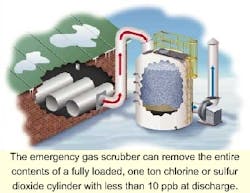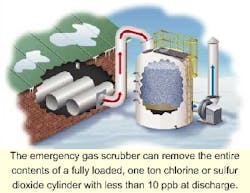Scrubber Protects Against Chlorine Releases
Facilities storing hazardous quantities of toxic chemicals were required under the Clean Air Act Amendments to develop a Risk Management Plan (RMP) that included leak prevention strategies as well as hazard assessments and emergency response procedures. As part of its compliance strategy, a plant in Maineville, Ohio, installed a dry scrubber system to safely treat any chemicals accidentally released.
Project engineers for Maineville's Lower Little Miami wastewater treatment plant selected Purafil's Emergency Gas Scrubber (EGS) for its leak prevention strategy. The plant uses from one to two tons of chlorine and 150 pounds of sulfur dioxide to disinfect the 3.5 mgd of water discharged daily into the Miami River.
Purafil connected the EGS to the plant's chlorine and sulfur dioxide cylinder storage room. The unit consists of a self-contained, deep bed vessel with the capacity to handle the contents of one entire chlorine cylinder and one sulfur dioxide cylinder.
In the event of an accidental release of gaseous chlorine or sulfur dioxide, a blower draws the chemicals into the EGS. The gas-air mixture then feeds through the scrubber's bed of dry chemical media, which chemically reacts to neutralize the toxic gases, preventing their release to the environment. The scrubbed air discharges through a high stack.
The unit's only moving part is the blower, which simplifies maintenance. The mass transfer limitations associated with diffusion across a liquid vapor phase boundary do not apply to the EGS. It can scrub toxic gas efficiently at a load rate greater than 400 pounds per minute and discharge less than 10 ppb contaminant.
Scrubbing Media
The heart of Purafil's dry scrubbing system is granular, dry chemical, gas-phase air filtration media. It removes odorous and toxic gases via absorption, adsorption or chemisorption. Absorption is a physical process in which a substance is taken in and combines or merges into another material. Adsorption occurs when the media captures gaseous molecules and holds them to the media surface. Chemisorption occurs when the media reacts with gaseous molecules and changes their chemical form to a nontoxic end product.
The company recommends quarterly testing to determine media capacity. Small leaks over time will diminish the capacity of the media. To ensure that the worst case scenario capacity remains, the unit has a designed safety margin. Operators pull a sample of the media quarterly or whenever a leak has occurred. Purafil conducts analytical testing to determine the remaining media capacity. When testing indicates the media's chlorine fixing capacity has diminished, then the media should be replenished.
The company's Chlorosorb media consists of manufactured, spherical porous pellets composed of activated alumina-based substrate impregnated with sodium thiosulfate. The pellet formation process impregnates a minimum of five percent sodium thiosulfate content uniformly throughout the pellet, enhancing the capacity for removing chlorine. The media meets a minimum removal capacity of 8.0 percent, i.e. one hundred pounds of media can remove eight pounds of chlorine.
The UL Class One rated Chlorosorb media weighs 50 pounds per cubic foot. It performs in temperatures ranging from -40 to 125°F and in humidities from 10 percent to 95 percent. Airflows can range from less than 25 CFM to over 100,000 CFM. Purafil's patented Puracarb is designed for removal of both chlorine and sulfur dioxide. This version of the media is rated UL Class Two for non-flammability.
The dry scrubber installation complies with Section 112(r)(7) of the 1990 Clean Air Act Amendments.

